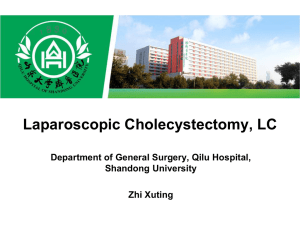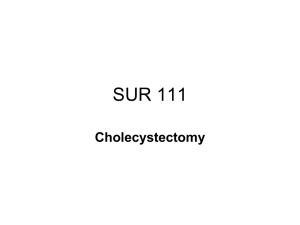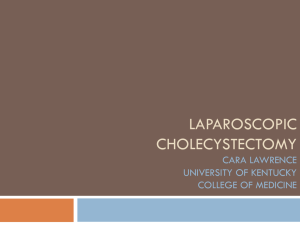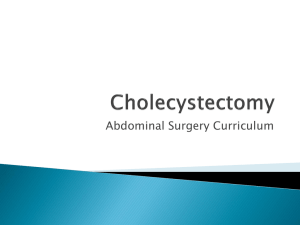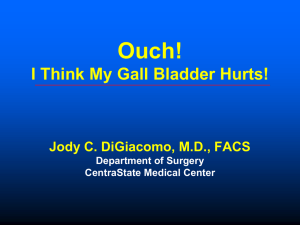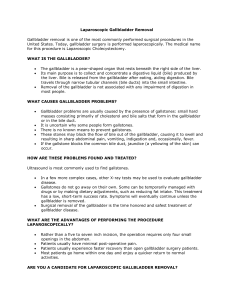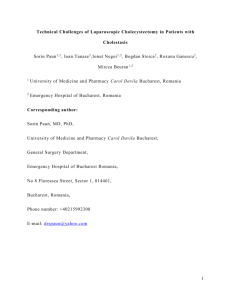Surgical Diseases of the Liver
advertisement
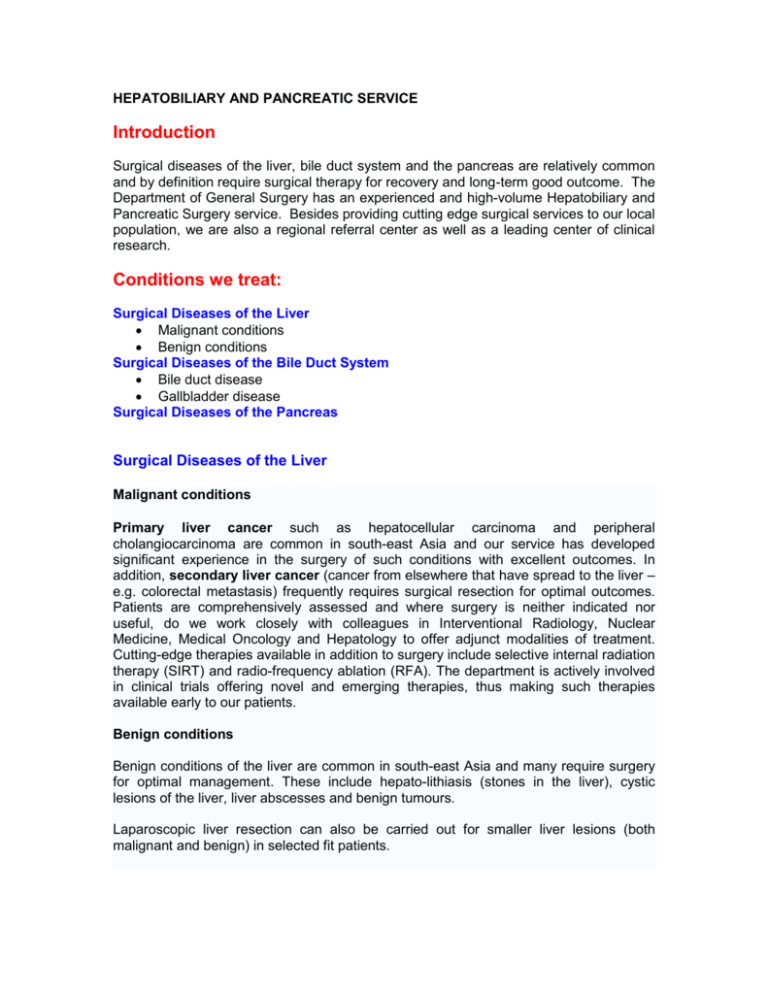
HEPATOBILIARY AND PANCREATIC SERVICE Introduction Surgical diseases of the liver, bile duct system and the pancreas are relatively common and by definition require surgical therapy for recovery and long-term good outcome. The Department of General Surgery has an experienced and high-volume Hepatobiliary and Pancreatic Surgery service. Besides providing cutting edge surgical services to our local population, we are also a regional referral center as well as a leading center of clinical research. Conditions we treat: Surgical Diseases of the Liver Malignant conditions Benign conditions Surgical Diseases of the Bile Duct System Bile duct disease Gallbladder disease Surgical Diseases of the Pancreas Surgical Diseases of the Liver Malignant conditions Primary liver cancer such as hepatocellular carcinoma and peripheral cholangiocarcinoma are common in south-east Asia and our service has developed significant experience in the surgery of such conditions with excellent outcomes. In addition, secondary liver cancer (cancer from elsewhere that have spread to the liver – e.g. colorectal metastasis) frequently requires surgical resection for optimal outcomes. Patients are comprehensively assessed and where surgery is neither indicated nor useful, do we work closely with colleagues in Interventional Radiology, Nuclear Medicine, Medical Oncology and Hepatology to offer adjunct modalities of treatment. Cutting-edge therapies available in addition to surgery include selective internal radiation therapy (SIRT) and radio-frequency ablation (RFA). The department is actively involved in clinical trials offering novel and emerging therapies, thus making such therapies available early to our patients. Benign conditions Benign conditions of the liver are common in south-east Asia and many require surgery for optimal management. These include hepato-lithiasis (stones in the liver), cystic lesions of the liver, liver abscesses and benign tumours. Laparoscopic liver resection can also be carried out for smaller liver lesions (both malignant and benign) in selected fit patients. Surgical Diseases of the Bile Duct System Such conditions are especially common in south-east Asia. Common conditions include gallbladder and bile duct stones, recurrent pyogenic cholangitis (RPC) and cancers of the gallbladder and the bile duct. Endoscopic and laparoscopic (Minimally invasive surgery or MIS) procedures are the main modalities of treatment in stone disease while special surgical techniques, including the creation of subcutaneous enteric access are used in the management of the more challenging cases of recurrent pyogenic cholangitis. Radical surgery is required for cancers of the bile duct and gallbladder, an area that the service has also developed significant expertise. Gallstone disease Surgical Diseases of the Pancreas These conditions include solid cancers of the pancreas, cystic lesions of the pancreas (both malignant and benign) as well as inflammation and stone diseases of the pancreas. Surgery of the pancreas is a specialized area and the best outcomes are in dedicated specialty centers. In addition to pancreatic resection and pancreatico-enteric by-passes, our service has also developed an international reputation in the management of the less common cystic lesions of the pancreas. Gallstone disease (content) What is the function of Gallbladder Who more frequently develops gallbladder problems What causes gallbladder problems What is the Gallbladder Treatment of Gallbladder stones Open Cholecystectomy Laparoscopic Cholecystectomy What is the Gallbladder The gallbladder is a small pear shaped organ that lies beneath in the upper right side of your abdomen under your liver. What is the function of Gallbladder Gallbladder stores bile and releases bile into the intestine, where it helps to digest fat at meal times. The gallbladder does not produce bile. Bile is produced by the liver. If the gallbladder is surgically removed, the liver continues to produce bile which similarly flows into the intestines Who more frequently develops gallbladder problems Women in their middle-age Men and women who are overweight Individuals with haemolytic diseases In Asia, patients tend to develop gallstones at a younger age compared to patients in the west. Many patients with gallstone disease have no obvious risk factors. What causes gallbladder problems The amount of bile and other fluid inside the gallbladder can become unbalanced. When this happens, some of the chemicals become solid and form gallstones. Treatment of Gallbladder stones While not all gallstones will cause problems for the patient (i.e. become symptomatic), gallstones can cause pain, infection and blockage of the flow of bile. When gallstones become symptomatic, surgery to remove the gallbladder is the recommended medical solution to gallbladder stone disease. The conventional or traditional surgical method to remove the gallbladder is Open Cholecystectomy performed through a skin incision of at least 10cm long in the right upper abdomen. An alternative surgical method (which has currently become the standard method), carries out this surgery through four short incisions of less than 1cm to remove the gallbladder. This technique is called Laparoscopic cholecystectomy. In patients with stones in the common bile duct, a separate procedure will need to be performed before Laparoscopic Cholecystectomy. The procedure is called endoscopic retrograde removal of common bile duct stones (ERCP). Laparoscopic cholecystectomy What is Laparoscopic cholecystectomy Length of hospital stay After surgery Advantages of Laparoscopic Cholecystectomy Complications What is Laparoscopic cholecystectomy Laparoscopic Cholecystectomy is a surgical technique of removal of the gallbladder. It is performed under general anesthesia. With this technique, the removal can be accomplished through 3 small 0.5 cm incisions and one 1.0 cm incisions. A laparoscopic camera attached to a video monitor is used to visualize the whole procedure. Surgery to remove the gallbladder is performed through these the 3 smaller incisions and removal is through the 1cm incision. If there is no active ongoing infection, laparoscopic cholecystectomy is successfully carried out 95% of the time. In about 5% of the time, conversion to open surgery is necessary because of aberration in the anatomy (i.e. unusual anatomy), acute inflammation of adhesions due to previous infection. Laparoscopic cholecystectomy is currently the standard surgical method of treating gallbladder stone disease. In some patients, the procedure may not be possible because of acute or chronic inflammation of the gallbladder or because of previous abdominal surgery. Such patients will then require conventional or open cholecystectomy. Laparoscopic cholecystectomy is otherwise a safe and successful in most patients. Length of hospital stay You will need to be admitted one day before or on the morning of your surgery. After laparoscopic cholecystectomy surgery, you will usually stay overnight and be discharged the next day at noon. Patient undergoing open surgery will usually need to stay at least one additional day. In younger fitter patients, laparoscopic cholecystectomy may be carried out as a daysurgery procedure, i.e. the patient may be able to go home in the evening of the same day. After surgery You will be observed in the ward for a few hours after surgery, after which you should be able to drink or even have a light meal. On the day following surgery, you should be able to take your normal diet and move around inhibited. Depending on how you feel you may be discharged the day after surgery. Day surgery patients may be discharged the same day. Post-operative pain is mild compared to conventional surgery and oral analgesics will be prescribed. No removal of stitches will be required. On discharge, you should rest at home for a week or two. You will be given a date to return to see your surgeon. Advantages of Laparoscopic Cholecystectomy Compared to conventional surgery, laparoscopic cholecystectomy has the following advantages: Minimises recovery time from surgery Allows for a shorter hospital stay Has less post-operative pain Has a better cosmetic result. Complications Possible complications of conventional and laparoscopic cholecystectomy are the same: Bleeding Bowel injury Wound infecion Bile duct injury and stricture All these complications are however uncommon. Gallbladder surgery is not considered high risk surgery. You should consult your surgeon earlier than the scheduled post-surgery appointment date if you feel unwell, especially if you develop: Fever of 38 degrees C and above. Jaundice or yellow discoloration of the skin and eyes Redness, swelling or discharge from the wound. Enquiries If you require further information, please email hpbsurgery@sgh.com.sg
